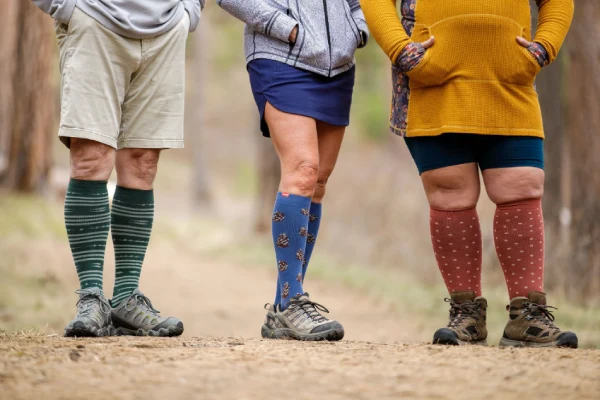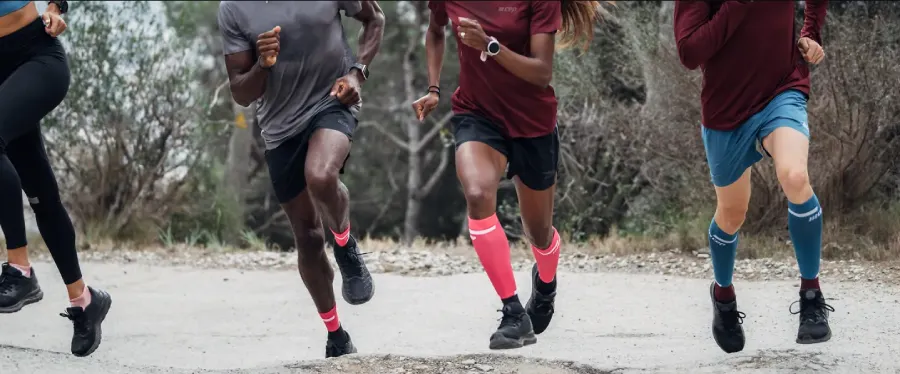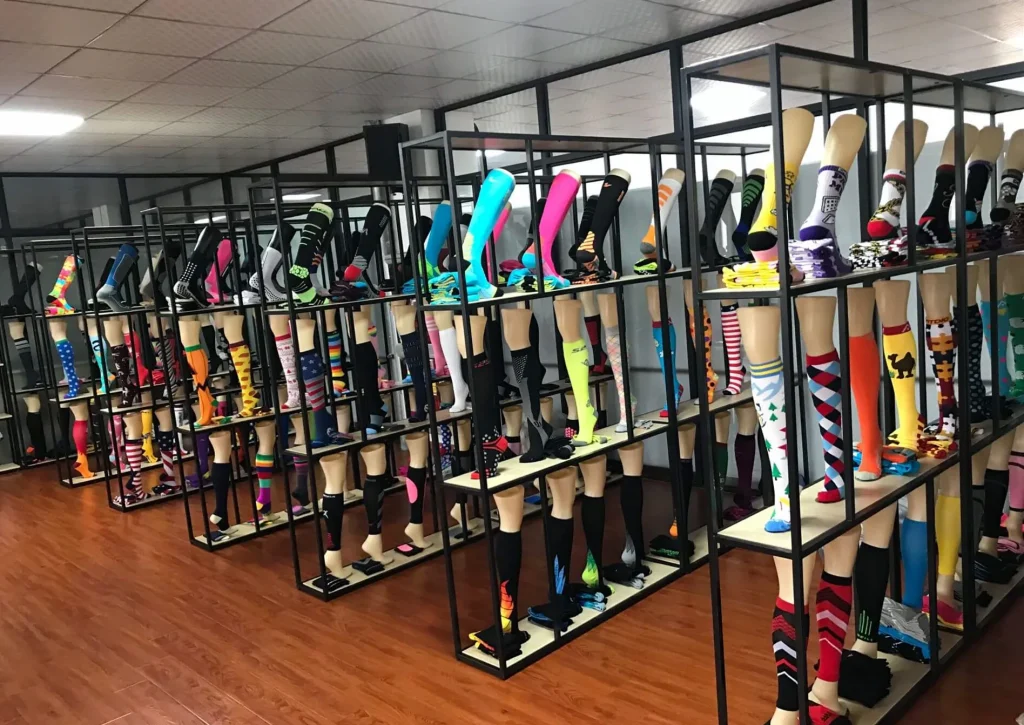Why More People Are Wearing Compression Socks While Walking
Compression socks are gaining popularity beyond hospitals and clinics. More walkers, commuters, pregnant women, and active adults are choosing compression socks to improve leg comfort and health. The key question is: are compression socks just a passing trend, or do they really offer genuine benefits while walking?
This article will explore the question “should I wear compression socks while walking” by explaining how compression socks work, who should wear them, how to choose the right type, and tips on proper use.
The “Magic” of Compression Socks: How Do They Actually Work?
Compression socks apply graduated compression — the pressure is strongest at the ankle and gradually decreases toward the calf. This pressure gradient helps the leg muscles and veins function more efficiently.

Mechanism of Action
- Boosts Blood Circulation
By squeezing the lower legs, compression socks improve venous return, helping blood flow back toward the heart more easily. This is why they’re sometimes called circulation socks. - Reduces Swelling
Compression socks help prevent fluid buildup in the legs, reducing edema. This is why terms like elastic stocking for edema and support hose for leg swelling are closely associated with compression therapy. - Stabilizes Muscles
The gentle pressure supports muscles during walking, which can reduce muscle fatigue and soreness. - Speeds Recovery
By enhancing circulation and stabilizing muscles, compression socks help the legs recover faster after activity.
Who Should (and Shouldn’t) Wear Compression Socks While Walking
Compression socks are not one-size-fits-all. Knowing who benefits most — and who should avoid them — is essential for choosing the right product.
Ideal Candidates for Daily Walking Use
Compression socks are great for:
- People with mild swelling or varicose veins: Wearing compression socks helps reduce fluid buildup and improve circulation.
- Pregnant women: Pregnancy often causes leg swelling and discomfort. Compression socks, especially pregnancy-specific styles, can relieve symptoms and support circulation.
- Older adults: Aging veins may weaken, leading to tired or swollen legs. Compression socks improve venous return and leg comfort.
- Diabetics: Specialized diabetic compression socks with seamless designs help reduce irritation and support sensitive skin.
- Regular walkers and commuters: Those who spend long hours on their feet benefit from reduced fatigue and swelling.

When to Avoid Wearing Compression Socks
Not everyone should wear compression socks without medical guidance:
- People with severe peripheral artery disease (PAD) or arterial insufficiency should avoid compression socks unless prescribed by a doctor.
- Individuals with skin infections, open wounds, or dermatitis on their legs should consult healthcare providers before use.
- Those with congestive heart failure need medical advice before compression therapy.
Doctor’s Advice and Usage Limits
For safe and effective use, consult a healthcare professional if you:
- Have underlying vascular or heart conditions
- Experience unexplained leg pain or swelling
- Are unsure about the correct compression level
Remember, improper use can cause discomfort or worsen some conditions.
How to Choose the Right Compression Socks for Walking
Choosing compression socks that fit your needs and walking habits is key to maximizing benefits and comfort.
Choose the Right Compression Level (mmHg)
Compression strength is measured in millimeters of mercury (mmHg). Common levels include:
- 15-20 mmHg: Light compression, suitable for mild swelling or edema, pregnant women, and daily wear. These compression socks help reduce leg swelling and improve comfort during walking.
- 20-30 mmHg: Moderate compression, recommended for managing edema symptoms, varicose veins, or for frequent walkers needing extra support. This pressure range is popular for compression socks for edema treatment.
- 30-40 mmHg: Higher compression used for more severe conditions, such as deep vein thrombosis (DVT), but should only be worn under medical supervision.
Compression Sock Types for Walking Comfort
When selecting compression socks, consider:
- Length: Knee-high compression socks are the most common choice for walking, offering effective calf support. For more extensive coverage, thigh high compression socks provide additional support up the leg.
- Toe Design: Open toe or toeless compression socks improve breathability and comfort, especially for diabetic users or those prone to foot swelling.
- Material: Breathable, moisture-wicking fabrics keep feet dry during walks. Some compression socks feature copper-infused fibers, similar to copper fit compression socks, which can help reduce odor and bacterial growth.
- Calf Size: For people with larger calves, plus size or wide calf compression socks ensure a comfortable fit without restricting circulation.

How to Measure for Compression Socks
Accurate measurements ensure you select the right size and compression level:
- Measure the circumference of your ankle at its narrowest point.
- Measure the widest part of your calf.
- For thigh-high socks, measure the circumference of your thigh as well.
- Measure the length from the floor to the bend behind your knee or thigh, depending on sock length.
Using these measurements, you can choose the correct size that delivers optimal pressure without discomfort.
Additional Tips
- Consider your daily walking distance and activity level when choosing compression strength.
- If you are new to compression socks, start with lighter compression and increase if needed.
- If you have specific medical conditions, consult your healthcare provider before purchasing.
How to Wear Compression Socks Properly for Walking
Proper wearing and care of compression socks ensure you get the full benefits while avoiding discomfort.
How to Put On Compression Socks
Putting on compression socks correctly can be tricky, but it’s important for comfort and effectiveness:
- Sit down and gently gather the sock inside out down to the heel.
- Place your foot inside and slowly roll the sock up your leg, making sure the fabric lies flat without wrinkles.
- Avoid bunching or folding as this can create pressure points.
- For thigh-high socks, ensure the top band fits snugly without digging into the skin.
How Long to Wear Compression Socks Daily
- For most walkers, wearing compression socks during walking sessions or for 6-8 hours daily provides good support.
- Some users wear them longer, but it’s best to follow medical advice, especially with higher compression levels.
- It’s generally safe to remove compression socks at night unless your doctor recommends sleeping in them.
Common Mistakes to Avoid
- Wearing the wrong size or compression level can cause discomfort or reduce effectiveness.
- Not measuring your legs before buying leads to poor fit.
- Wearing socks with wrinkles or folds can cause pressure spots and skin irritation.
- Ignoring care instructions can shorten the sock’s lifespan and compression performance.
Can You Sleep in Compression Socks?
Many wonder “can you sleep in compression socks?” The answer depends on your health:
- Light compression socks (15-20 mmHg) are generally safe to wear to bed for those with mild swelling or circulation issues.
- However, most people should avoid sleeping in higher pressure socks without medical advice, as they may restrict circulation during rest.
- Always consult your doctor if unsure.
For Brands, Retailers & Bulk Buyers
For businesses looking to add compression socks to their product lineup or customize bulk orders, understanding market needs and product options is key.
User Scenarios for Retailers to Consider
Retailers and brands should note that compression socks appeal to diverse groups:
- Active walkers and commuters seeking daily comfort
- Pregnant women needing leg support
- Older adults managing mild edema or circulation issues
- Medical patients requiring specific pressure levels for recovery or prevention
Offering a range of compression levels and styles, such as knee-high, thigh-high, open toe, and wide calf options, can meet varied customer demands.
Building an Effective Compression Sock Product Line
A well-rounded product line might include:
- Light (15-20 mmHg) and moderate (20-30 mmHg) compression socks
- Various sizes, including plus size and wide calf models
- Specialty socks like copper-infused or diabetic-friendly compression socks
- Packaging that highlights benefits such as improved circulation and swelling reduction
Providing clear size charts and educational material on how to measure for compression socks helps customers select the right fit and pressure.
OEM/ODM Support from Max Hosiery
Max Hosiery offers flexible OEM and ODM services to help brands customize compression socks:
- Custom designs including colors, logos, and packaging
- Variety of materials including copper-infused fibers for odor control
- Assistance with choosing appropriate compression levels for target markets
- Quality assurance to meet international standards
Partnering with a reliable factory ensures consistent product quality and timely delivery, crucial for brand reputation and customer satisfaction.
Summary and Recommendations
Compression socks provide clear benefits for walking, including improved circulation, reduced swelling, and muscle support. They are suitable for many groups such as pregnant women, older adults, diabetics, and regular walkers. Choosing the right compression level, size, and style is essential to maximize comfort and effectiveness.

For brands and retailers, offering a diverse product line that meets various customer needs—from light 15-20 mmHg knee-high socks to specialty wide calf and copper-infused options—can drive sales and customer satisfaction. Partnering with a trusted factory for customization and quality assurance, like Max Hosiery, helps streamline your supply chain and build competitive advantage.
FAQ
Q1: Can you sleep in compression socks?
A: Light compression socks (15-20 mmHg) are usually safe to wear to bed if you have mild swelling or circulation issues. Higher compression socks should be worn during the day unless advised by a doctor.
Q2: How long should you wear compression socks while walking?
A: Typically, wearing compression socks during walking sessions or for 6-8 hours daily provides optimal support and comfort.
Q3: How do you measure for compression socks?
A: Use a flexible tape to measure the narrowest part of your ankle, the widest part of your calf, and for thigh-high socks, the circumference of your thigh.
Q4: Who should not wear compression socks?
A: People with severe arterial disease, skin infections, or congestive heart failure should consult a healthcare professional before use.
Q5: Are copper-infused compression socks better?
A: Copper-infused socks help reduce odor and bacterial growth, providing additional comfort especially for active users.
